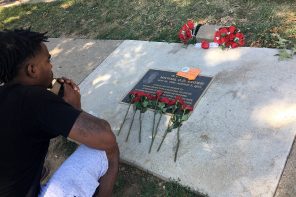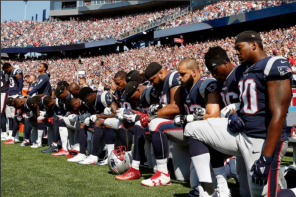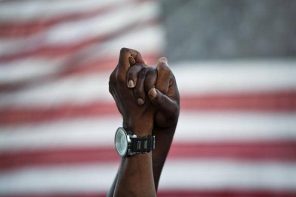By now many in the LGBTQ community have heard of the news about the police beating of Duanna Johnson, captured on surveillance video in a Memphis jailhouse. Those of us, especially of African descent, who don’t know or haven’t seen a photo of Johnson, might pick up on a cultural marker—her name—and correctly assume she’s an African American sister.
While police brutality is both unbridled and rampant in the African American community, this story carries a special shock. When an African American woman is hit repeatedly by an officer with with handcuffs wrapped around his knuckles, and an African American nurse goes directly to the offending white officer to see if he’s okay we get a hint of another cultural marker—Johnson is a transsexual.
Monica Roberts, founder of the African American transpeople group Transsistahs-Transbrothas, responded recently in her blog on the Bilerico Project Web site: “While I applaud you [NAACP] for declaring a state of emergency over the treatment of African-Americans by the police, I have yet to hear any NAACP local, state or the national chapter speak up not only about this case, but about the verbal and physical hate attacks on African-American transpeople in general. As Duanna Johnson’s case graphically points out, some of the problems we transpeople of African descent face are at the hands of the people who are supposed to protect and serve us,” The post was titled:“Yo NAACP, NBJC…Where Y’all At?”
But while major African American organizations in this country were appallingly silent on the Johnson case, so were the black media—the Duanna Johnson story will not be featured in Jet, Ebony, or Essence.
And although I am thankful that the gay news media have captured the details surrounding Johnson’s arrest, the real story has not been told. And that story is how the intersection of racism and transphobia unleashes its rage on the body of black transgenders. This type of violence that is endemic in the black community, and that is something black media should have reported.
Very little is understood about transgender people, relegated as they are to the fringes of society; crimes against transgender people often go unnoticed, or are seen as lesser crimes. And the fact that Johnson walked away with her life just means she’s lucky—the extreme violence that transgender people are subjected to is often fatal.
To cite just one example of many: in 1998 Rita Hester, a 34-year-old African American transsexual, was murdered. Ms. Hester was a male to female pre-op transsexual woman who was found dead inside her first floor apartment in Allston, just outside of Boston, with multiple stab wounds to her chest.
But the other crime against Rita Hester was the media coverage. While black media did not cover the case, the Boston Herald did, referring to Ms. Hester as “he,” or “a transvestite,” or “William,” or “an enigma,” and stating that even her neighbors didn’t know who she was until the time of her death. This type of news coverage is not only damaging, disrespectful and demeaning to the entire transgender community but it helps confuse the public about the lives of transgender people and make them even more vulnerable to ridicule, confusion, ignorance, and hate crimes.
Duanna Johnson has explained that the officer’s attack on her was because she refused to respond to the derogatory names he called her. ”Actually he was trying to get me to come over to where he was, and I responded by telling him that wasn’t my name—that my mother didn’t name me a ‘faggot’ or a ‘he-she,’ so he got upset and approached me. And that’s when it started.” Calling a trans person out of his or her name is unfortunately a daily indignity most face. Racism adds another indignity. ”A white person who transitions to a male body just became a man. I became a Black man. I became the enemy,” London Dexter Ward, an LAPD cop who transitioned in 2004, told Alternet.org.
And it wasn’t until Louis Mitchell became a black man that he learned that “driving while black” would be such an offense. Mitchell, who resides in Springfield, MA, told ColorLines that he gets pulled over “300 percent more now than in his 23 years of driving.” Issues of race, gender expression, and sexual orientation trigger a particular type of violence against all people of color that black media cannot afford to let go unreported. Not reporting what is going on its LGBTQ community not only subjects us to constant violence that goes unchecked, but also puts the larger African American community at risk.
There are three reasons, I think, for the under-reporting of these stories in the black press, all dealing with homophobia and transphobia.
The first reason is the “politics of silence.” Black media is so homo- and transphobic that it will not report hate crimes against its LGBTQ community. But the black LGBTQ community can be silent too, for a different reason. It has often internalized the black community’s homo and trans phobias. Being openly queer often means being already estranged, if not completely alienated from our communities of color. Reporting attacks against us by other people of color in our communities as well as by the police can make victims be viewed as race traitors. So we end up colluding in the violence against us.
The second reason has to do with the dearth of openly LGBTQ reporters in black media writing on queer topics. This month for the first time in the history of the Bay State Banner, an African American newspaper in Greater Boston, an article appeared on black queer culture titled “Pride, Family values shine in Hub’s gay black culture.” Why now? Because Katherine Patrick, the daughter of our governor, Deval Patrick, who’s the second African American to be elected governor in the U.S., came out. The media attention surrounding her coming out finally underscored the fact that we have always been a part of the black community.
The third reason is the “politics of avoidance.” Black media won’t broach the topic of hate crimes against its LGBTQ population for fear it would be one more reason for white media to view violence as being synonymous with people of color.
The end result of this kind of homo- and transphobia in black media is that it not only revictimizes those of us targeted by these type of hate crimes, but also puts the entire community at risk.




